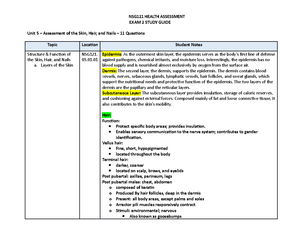- Information
- AI Chat
Was this document helpful?
HA Exam 1 - Exam 1 Blueprint
Course: Health Assessment (NSG 121)
205 Documents
Students shared 205 documents in this course
University: Herzing University
Was this document helpful?

NSG121 Health Assessment Exam 1 Study Guide
CULTIVATE A SPIRIT OF INQUIRY
The Nurse’s Role in Health Assessment
To Promote health, to prevent illness, to treat human responses to
health or illness, to advocate for individual, families, communities, and
populations
Types of Assessments
Emergent assessment: Life Threatening, Unstable, ABCs compromised
General Survey: Begins immediately upon meeting the patient and
continues throughout the assessment. No measurements are done
Focused: Patient is Stable- Based on patient’s health issues (what they are
in for)
Comprehensive: Assess everything, admission, all body systems, Complete
health history and physical assessment
_________________________________________________________________
Levels of Intervention to Promote Healthy Change
Primary : Preventing Problems, Vaccines, Health Teaching, Safety
Precautions
Secondary: Screening to Promote the early diagnosis of health problems
Mammogram, eye exams, smoking cessation, Vision Screenings, Paps
Tertiary : Focuses on preventing complications of an existing disease and
promoting health to the highest level
Medication, Surgical Treatment, Physical Therapy
_________________________________________________________________
Assessment Frameworks
Functional- Focuses on the functional patterns that all humans share
-Health Perception, activity and exercise, nutrition and metabolism, sleep
and rest, cognition and perception, self-perception, self-perception and self-
concept, roles and relationships, stress tolerance, values and beliefs,
sexuality, and reproduction
Head-to-Toe- Most organized system for gathering comprehensive physical
data







